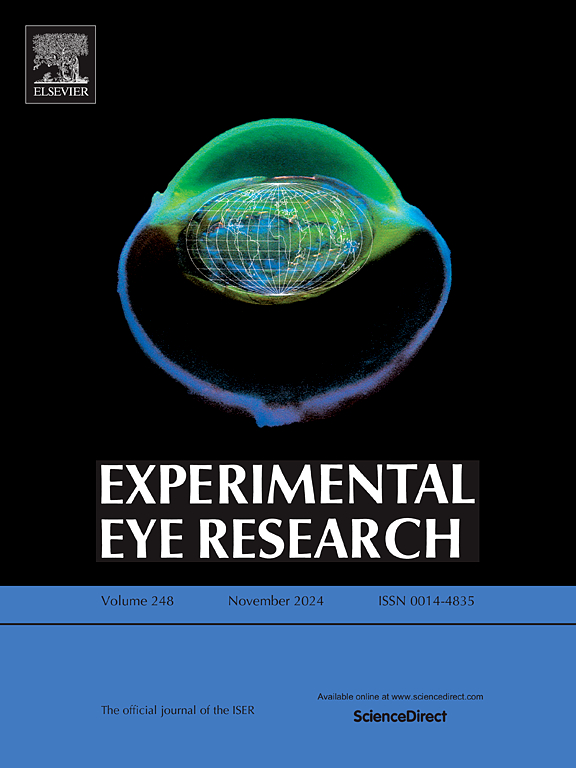去铁酮通过抑制实验性视网膜剥离后的铁蛋白沉积来保护感光细胞。
IF 3
2区 医学
Q1 OPHTHALMOLOGY
引用次数: 0
摘要
视网膜神经上皮细胞与视网膜色素上皮细胞(RPE)脱离通常是由于视网膜撕裂和随后的视网膜下积液(SRF)积聚造成的,在视网膜脱离(RD)情况下,这是导致感光细胞(PR)死亡和永久性视力损伤的关键因素。预测术后视力恢复具有挑战性,即使是手术再接也是如此。研究表明,玻璃体液(VF)中铁和转铁蛋白(TF)饱和度的增加与较差的视觉结果相关,这表明铁蜕变(一种调节细胞死亡的形式)在 RD 后的视网膜脱落中可能发挥作用。为了探索这一假设,我们分析了 RD 患者玻璃体液中的铁变态反应标记物,结果发现谷胱甘肽过氧化物酶 4 (GPX4)、谷胱甘肽 (GSH) 和还原型烟酰胺腺嘌呤二核苷酸磷酸 (NADPH) 水平降低,同时长链酰基-CoA 合成酶 4 (ACSL4)、丙二醛 (MDA) 和亚铁水平升高。我们随后建立了一个模拟 RD 的小鼠模型,并施用铁螯合剂去铁酮(DFP)作为治疗。我们的研究结果表明,去铁酮能减轻视网膜中的铁突变,从而保护视网膜的结构和功能。总之,我们的研究证实了铁突变在 RD 中的发生,并证明了 DFP 在保护 PR 和治疗 RD 方面的治疗潜力。本文章由计算机程序翻译,如有差异,请以英文原文为准。
Deferiprone protects photoreceptors by inhibiting ferroptosis after experimental retinal detachment
The detachment of the retinal neuroepithelium from the retinal pigment epithelium (RPE), often due to a retinal tear and subsequent subretinal fluid (SRF) accumulation, is a critical factor leading to photoreceptor cells (PR) death and permanent vision impairment in retinal detachment (RD) scenarios. Predicting postoperative visual recovery is challenging, even with surgical reattachment. Research has indicated that increased iron and transferrin (TF) saturation in the vitreous fluid (VF) correlates with poorer visual outcomes, suggesting a potential role for ferroptosis, a form of regulated cell death, in PR following RD. To explore this hypothesis, we analyzed the VF of RD patients for ferroptosis markers, revealing reduced levels of glutathione peroxidase 4 (GPX4), glutathione (GSH), and reduced nicotinamide adenine dinucleotide phosphate (NADPH), alongside elevated levels of Long-chain acyl-CoA synthetase 4(ACSL4), malondialdehyde (MDA), and ferrous iron. We then developed a mouse model to simulate RD and administered the iron chelator deferiprone (DFP) as a treatment. Our findings indicated that DFP mitigated ferroptosis in the retina, thereby preserving retinal architecture and function. Collectively, our study establishes the occurrence of ferroptosis in RD and demonstrates the therapeutic potential of DFP in protecting PR and treating RD.
求助全文
通过发布文献求助,成功后即可免费获取论文全文。
去求助
来源期刊

Experimental eye research
医学-眼科学
CiteScore
6.80
自引率
5.90%
发文量
323
审稿时长
66 days
期刊介绍:
The primary goal of Experimental Eye Research is to publish original research papers on all aspects of experimental biology of the eye and ocular tissues that seek to define the mechanisms of normal function and/or disease. Studies of ocular tissues that encompass the disciplines of cell biology, developmental biology, genetics, molecular biology, physiology, biochemistry, biophysics, immunology or microbiology are most welcomed. Manuscripts that are purely clinical or in a surgical area of ophthalmology are not appropriate for submission to Experimental Eye Research and if received will be returned without review.
 求助内容:
求助内容: 应助结果提醒方式:
应助结果提醒方式:


